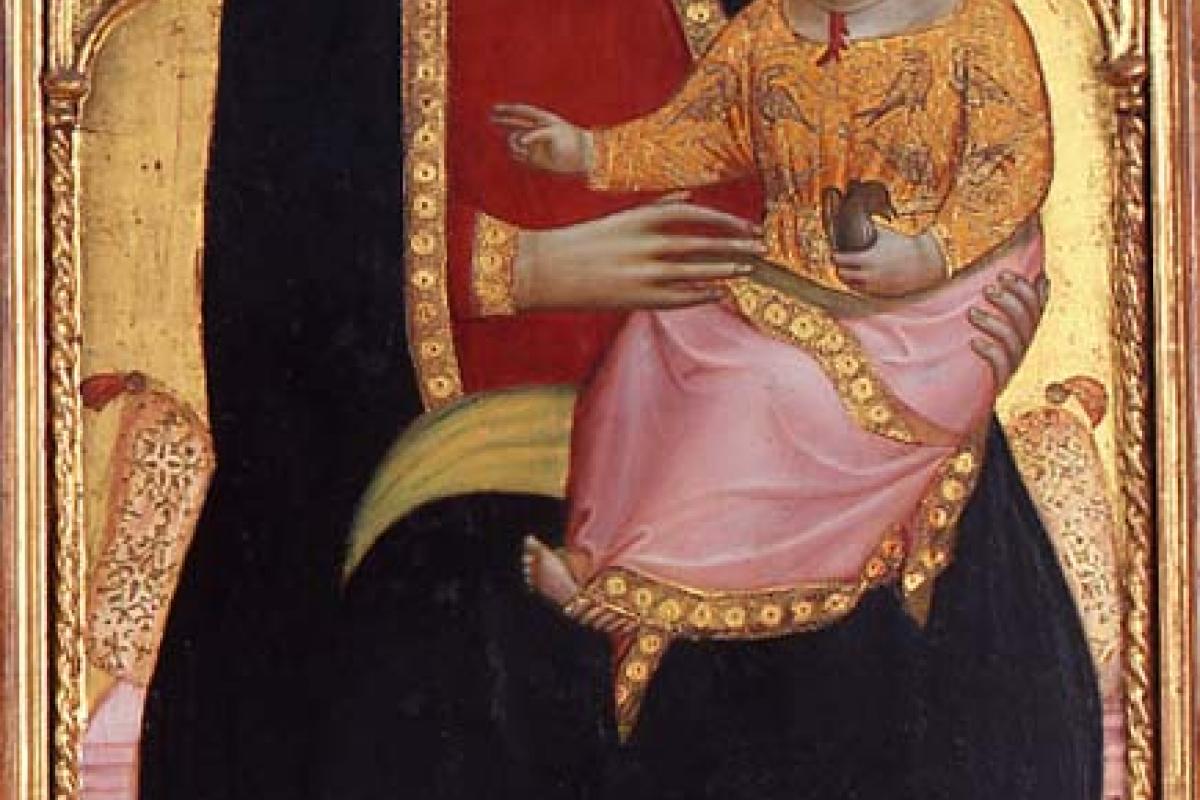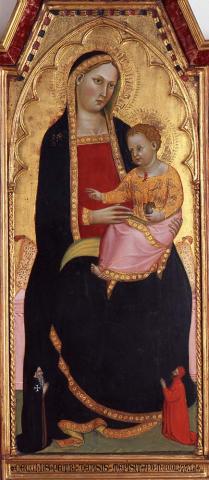Madonna and Child with Donors
Cecco di Pietro (Italian painter, active 1370, died before 1402)
Madonna and Child with Donors
Italian, 1386
Late Medieval
tempera on wood panel
height 124 cm
width 53 cm
Inscription in medieval Latin: Cecchus Petri de Pisis Mepisit AD MCCCLXXXVI [Translation: Cecchus Petro of Pisa [mepisit] 1386], painted in media, along bottom of frame.
Portland Art Museum, 61.44
Gift of the Samuel H. Kress Foundation
Cecco di Pietro at the Portland Art Museum – Podcast via Vimeo
Leah Fields, Natalie Fertig, and Katherine Barich, Medieval Portland Capstone students, 2014
Victor Soares, Medieval Portland Capstone Student, Winter 2005
Cecco di Pietro was a late 14th-century Italian painter in Pisa. His first documented work was done in 1370-71, when he collaborated with Francesco da Volterra in restoring the fresco, the Story of Job, in the Camposanto, a cathedral complex in Pisa. It is believed that Cecco developed much of his style during his work at the Camposanto. Cecco's earliest signed individual piece was done in 1374. After this year, he created many paintings, some of which are still intact and can be found in Italian churches as well as museums and private collections around the world.
The Madonna and Child with Donors was painted in 1386 by Cecco di Pietro in Pisa, Italy. The painting renders the Virgin Mary sitting on a bench with the baby Jesus on her lap. Kneeling at Mary's feet are two tiny men representing the donors that commissioned the piece. The brightly colored clothing that baby Jesus is wearing draws the eye to his figure thus making him the focal point of the piece.
Cecco uses techniques common in the time period but departs from the Pisan style in which he was schooled. The personages in the painting are elongated and he emphasizes linear decoration and remote facial expressions. Cecco di Pietro also uses a common 14th-century decoration technique called "punched decoration" - flattened pieces of metalwork with designs embedded in the painting. This Madonna and Child was once part of a polyptych, a multiple panel piece, now scattered to several collections. Two panels, one of St. Peter and the other of St. Bartholomew, are in the Nantes Museum and two other panels, one of St. John the Baptist and the other of St. Nicola, are in the Rennes Museum.
Cecco di Pietro created several Madonna and Child paintings, with little variation among the surviving paintings. In fact, the composition remains almost identical; Mary is always sitting in the same pose on a bench with pillows behind her. The only compositional variation is the position in which the baby Jesus is seated. The Christ Child wears a coral necklace as protection against evil and he holds a finch in his hands as a symbol of his future sacrifice.
The donor figures in the Portland Art Museum piece are elements that set it apart from other Madonna and Child paintings were done by Cecco, which makes the Portland piece especially interesting and unique. It can be inferred that the gentleman on the left, dressed in black with the Cross of Malta on his sleeve, was a member of the Knights of Malta. At the time of this painting, the organization was known as the Knights of the Order of St. John of Jerusalem, a military-religious order with the main purpose of defending pilgrims en route to and within the Holy Land, as well as caring for the sick. The order drew members exclusively from noble families; therefore, one can conclude that the donor Knight in this portrait possessed an affluent, aristocratic background. Less is known of the gentleman dressed in red on the right. The color and style of his clothing suggest that he was a high-ranking church official since it is typical of that of a cardinal.
Suggestions for further reading
Books
- Carli, Enzo. Pittura Pisana del Trecento
- Frinta, Mojmir S. Punched decoration: on late medieval panel and miniature painting
- Welch, Evelyn. Art and Society in Italy 1350-1500
- White, John. Art and Architecture in Italy 1250-1400
Websites
- Knights of Malta http://www.knightsofmalta.com/history/history.html
- The Metropolitan Museum of Art http://www.metmuseum.org/
Victor Soares, Medieval Portland Capstone Student, Winter 2005
Background Essay: Donor Portraits
A person who commissions an artwork and donates it to a church is called a "donor." Oftentimes, an artwork would include an image of the donor in the actual artwork. A work of art that includes the donor is called a "donor portrait." In a donor portrait the donor is shown venerating the religious figure depicted in the artwork or witnessing a sacred scene, and being shown in a painting with a saint was a high honor. Consequently, donating a piece of art to a church was a sign of piety but also served as a status symbol because only an affluent person had the resources to commission works of art during this time.
As time passed and the view of God and humanity's relationship with God changed, so did donor portraiture also change. In the medieval period, donors were commonly inserted into the artwork as tiny figures. Donor portraits in the Renaissance included the donors more prominently in the artwork, sometimes even incorporating the donor as an actor in the scene being depicted.
Suggestions for further reading
- Welch, Evelyn. Art and Society in Italy 1350-1500




